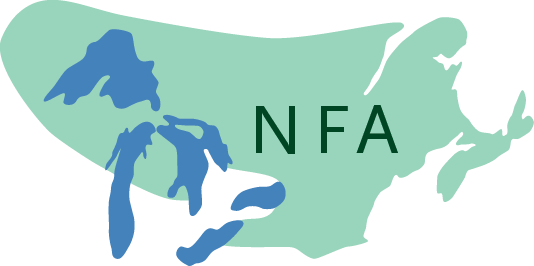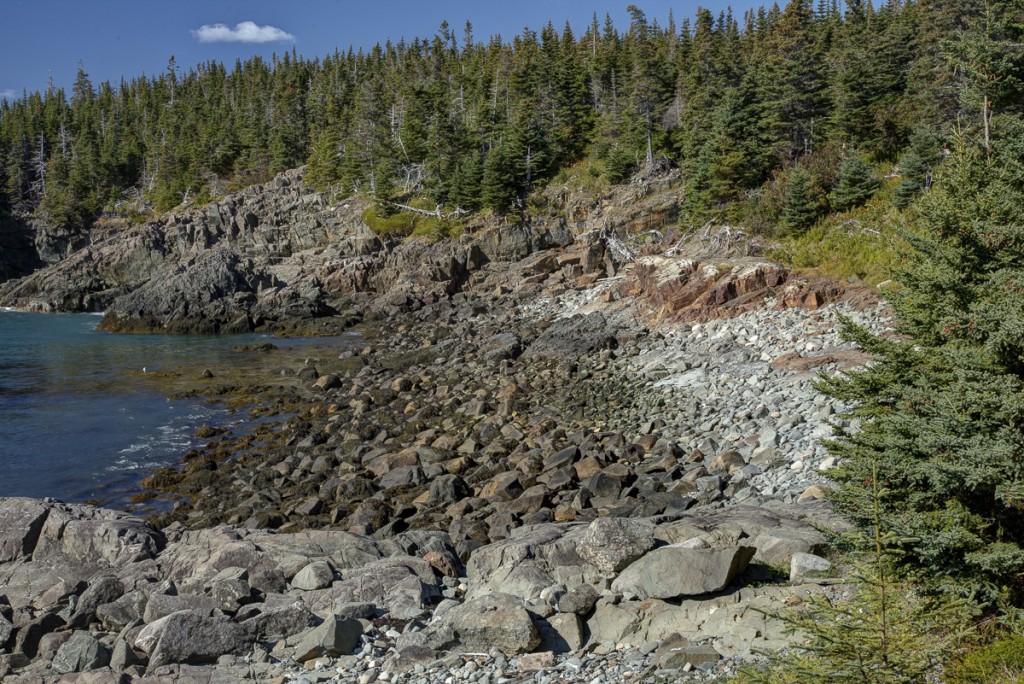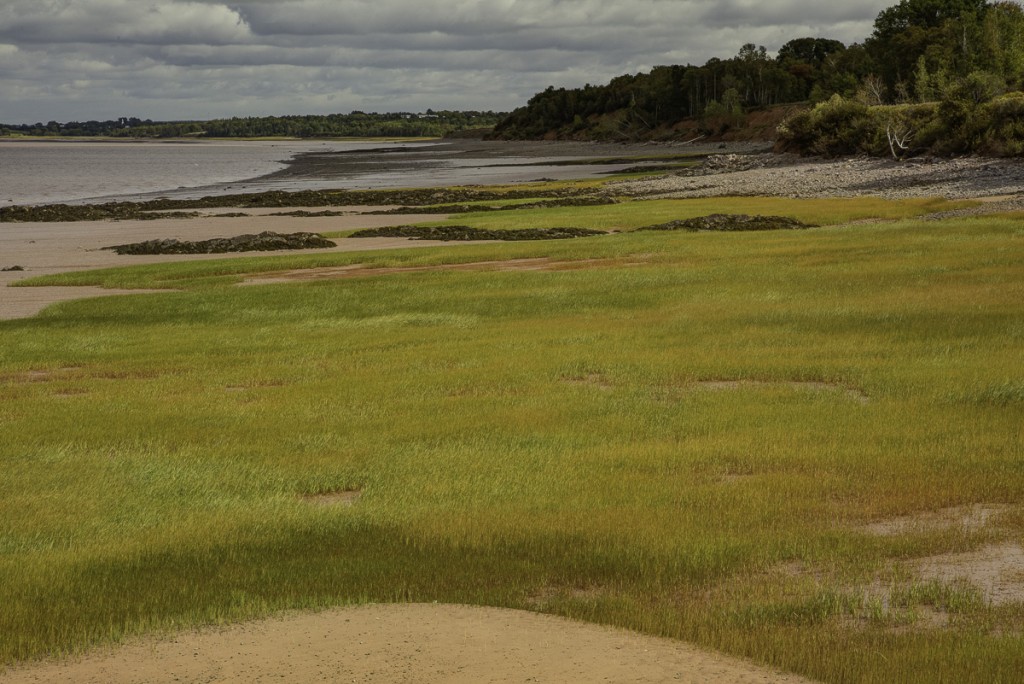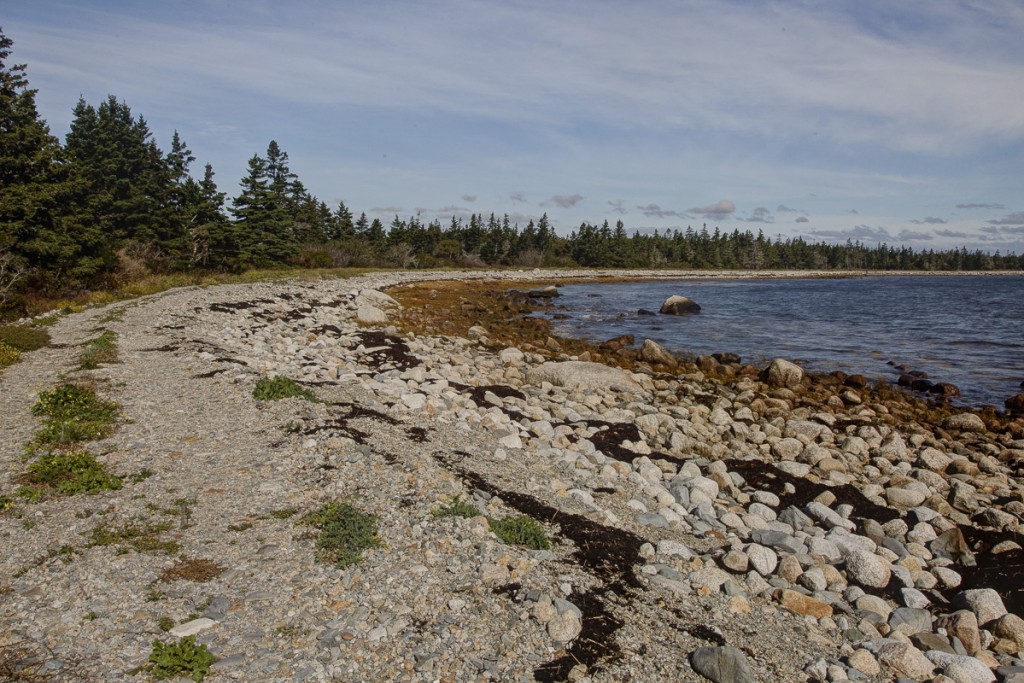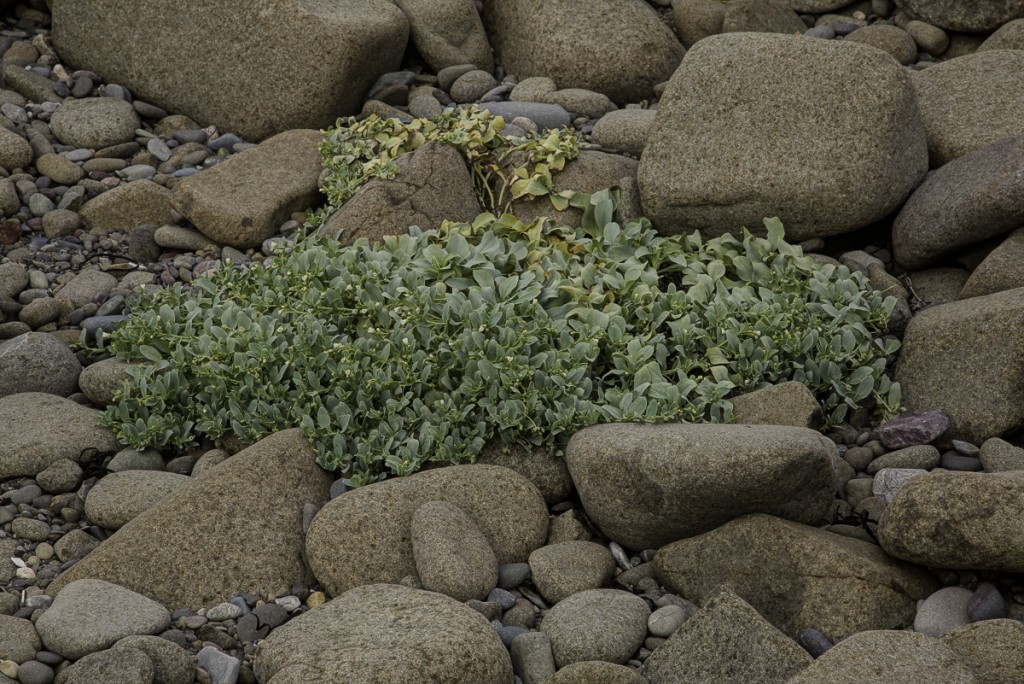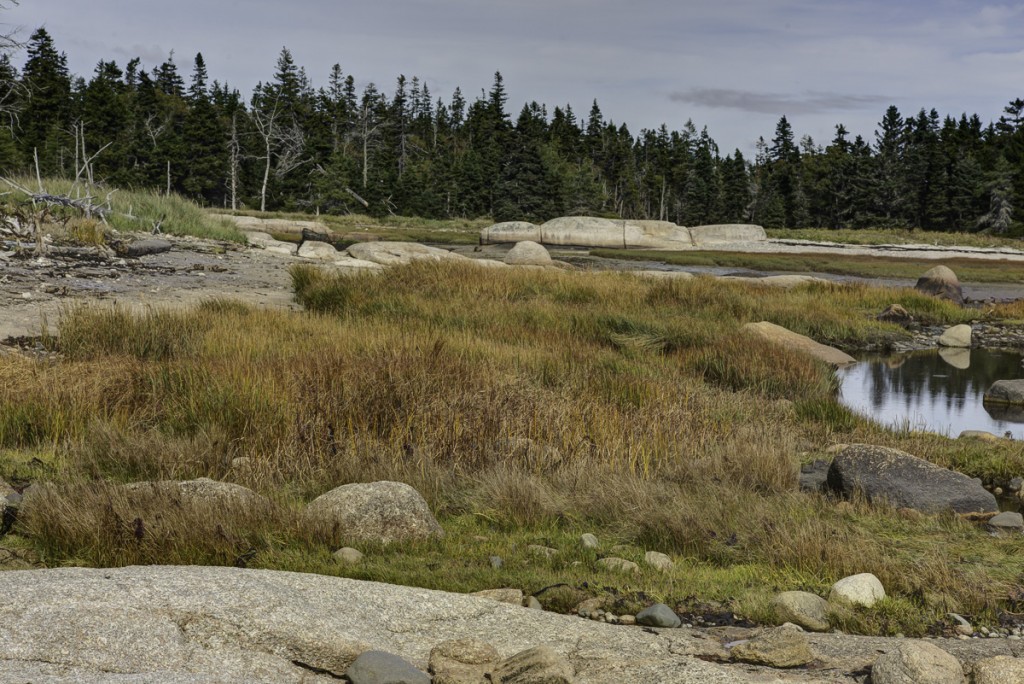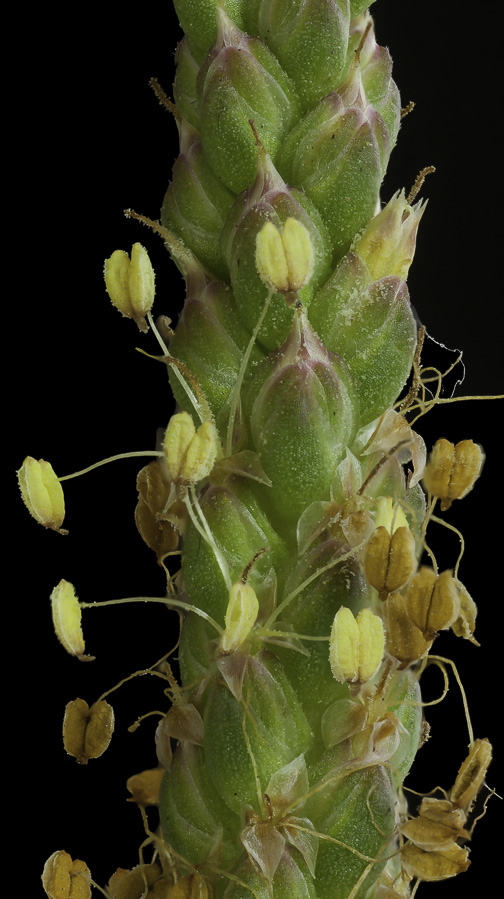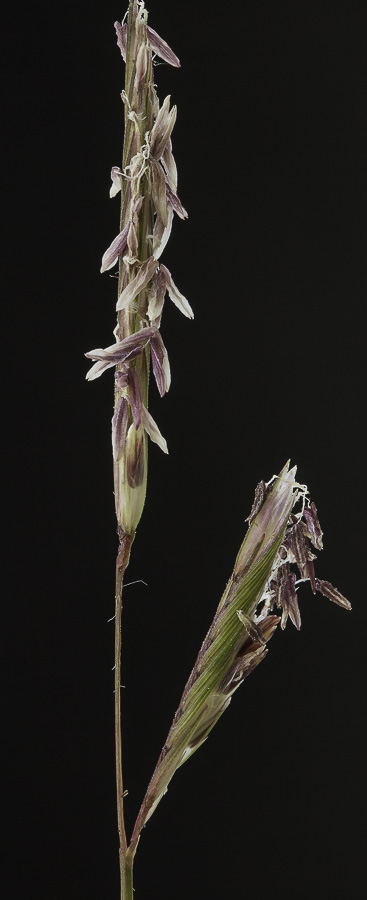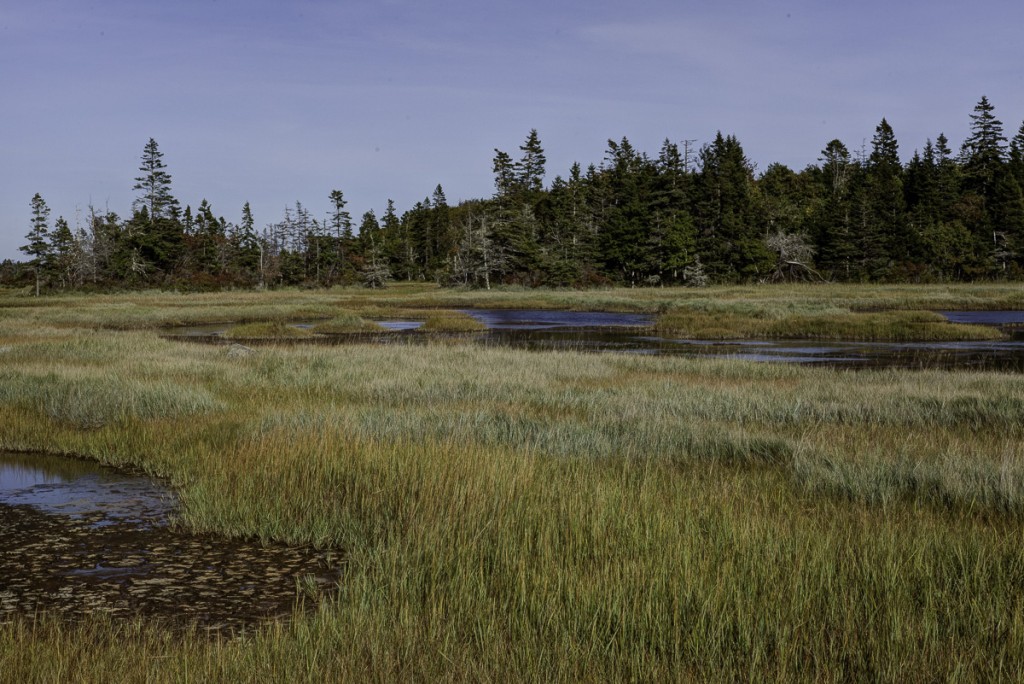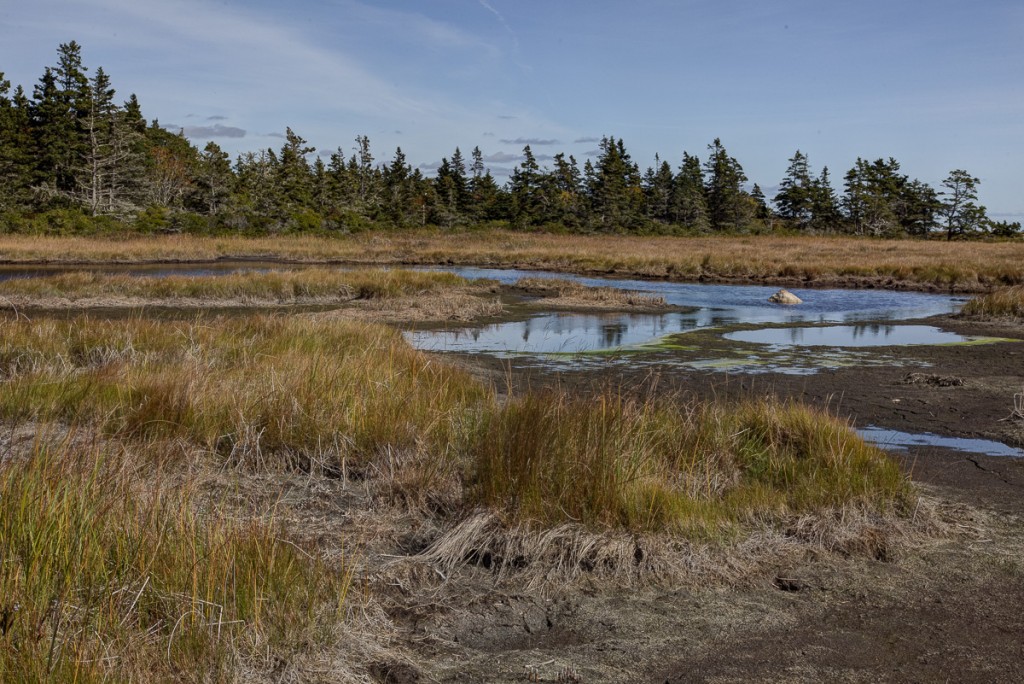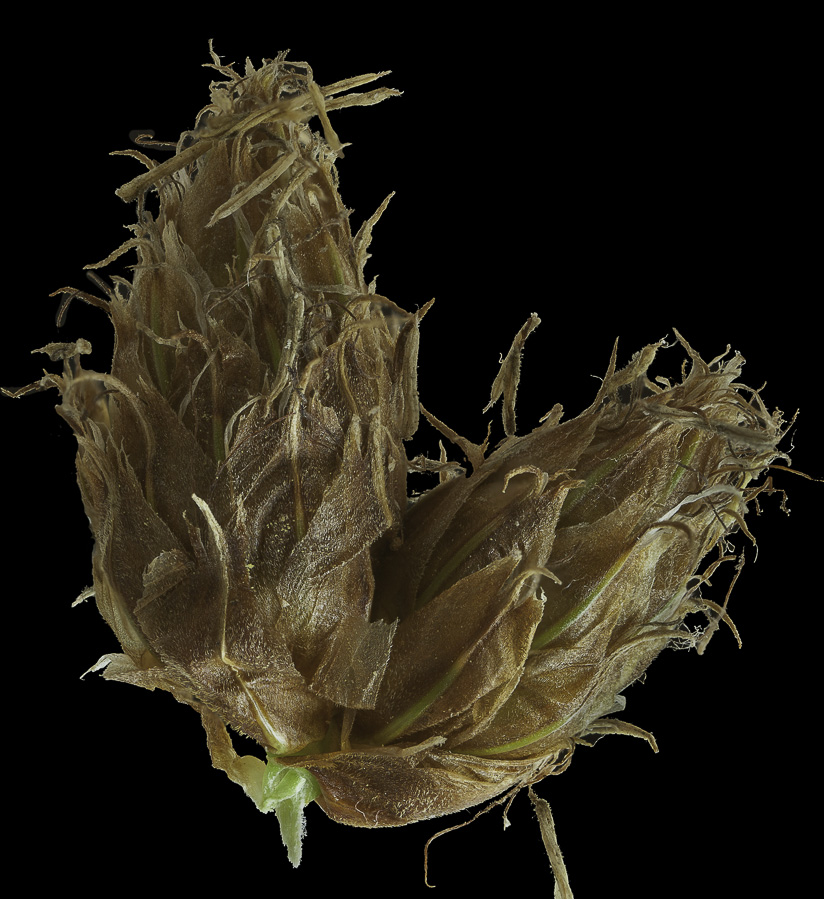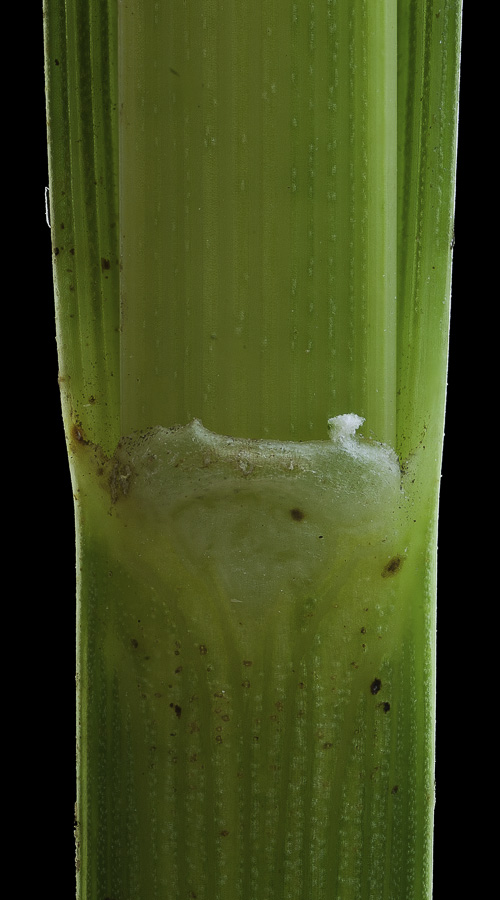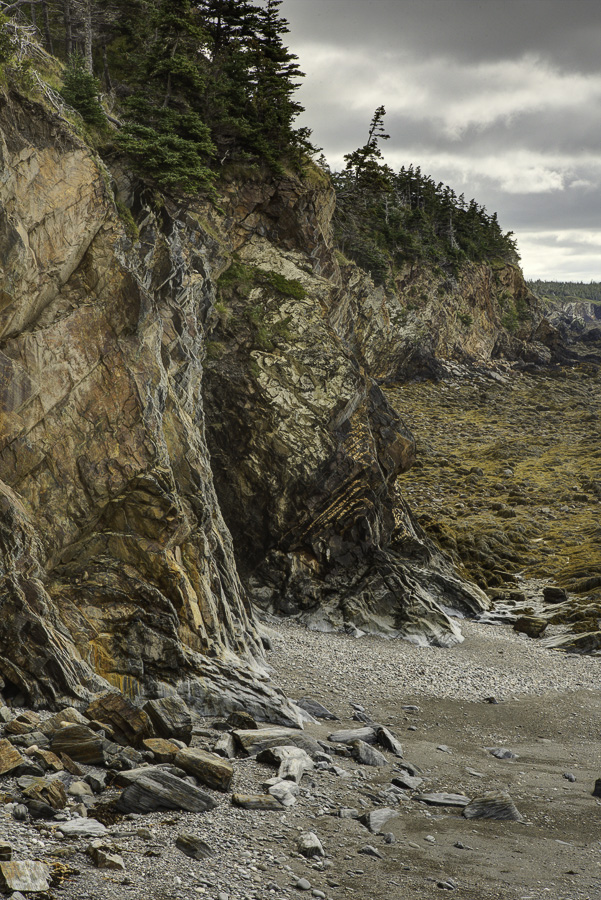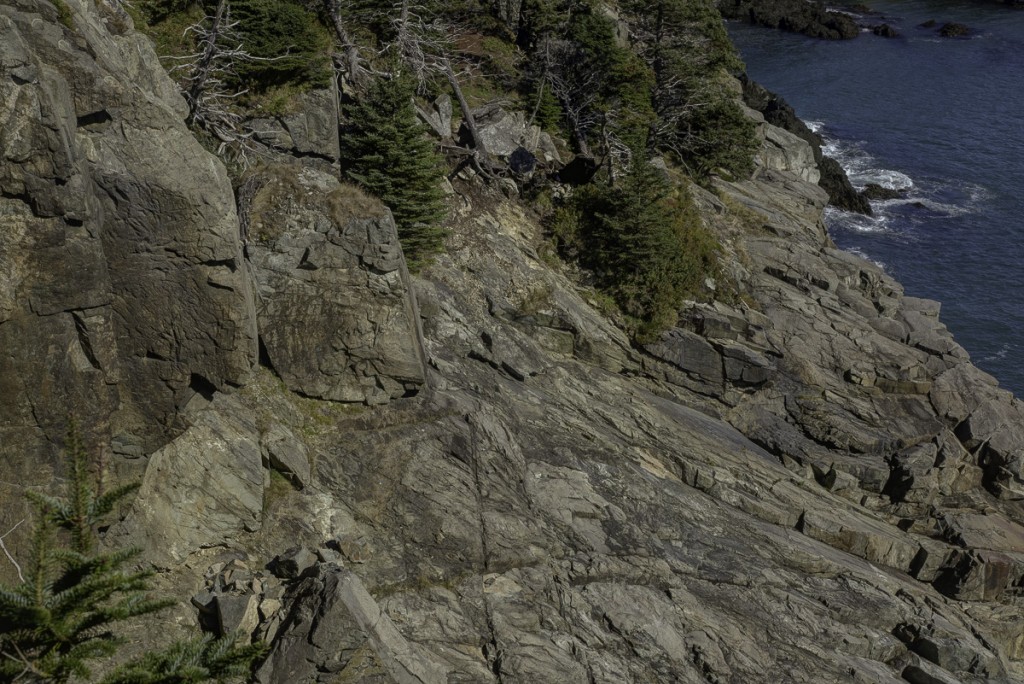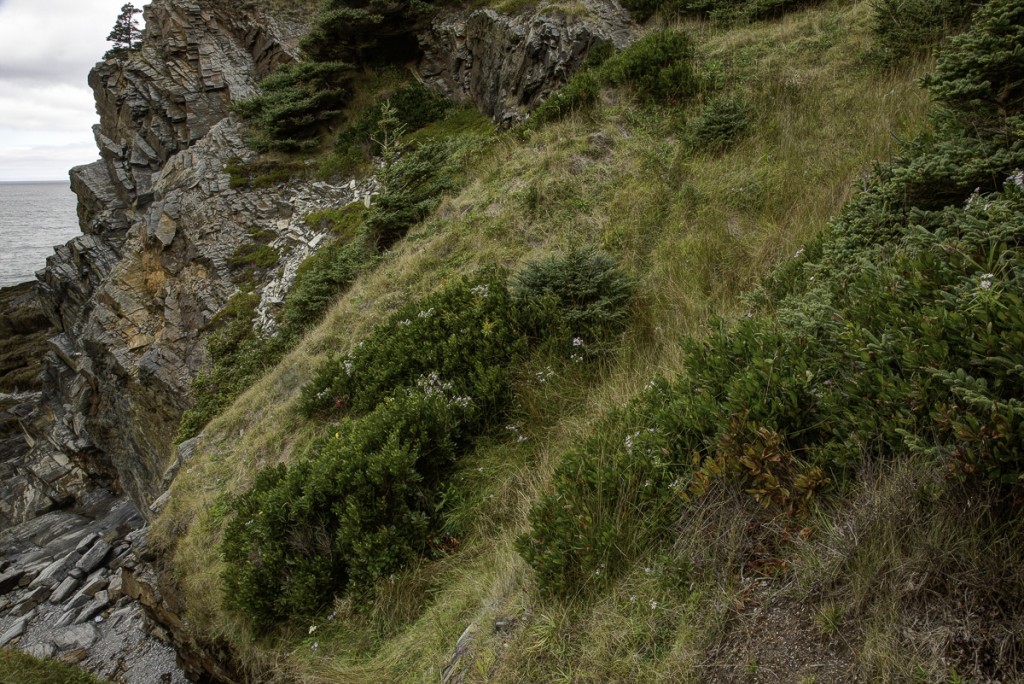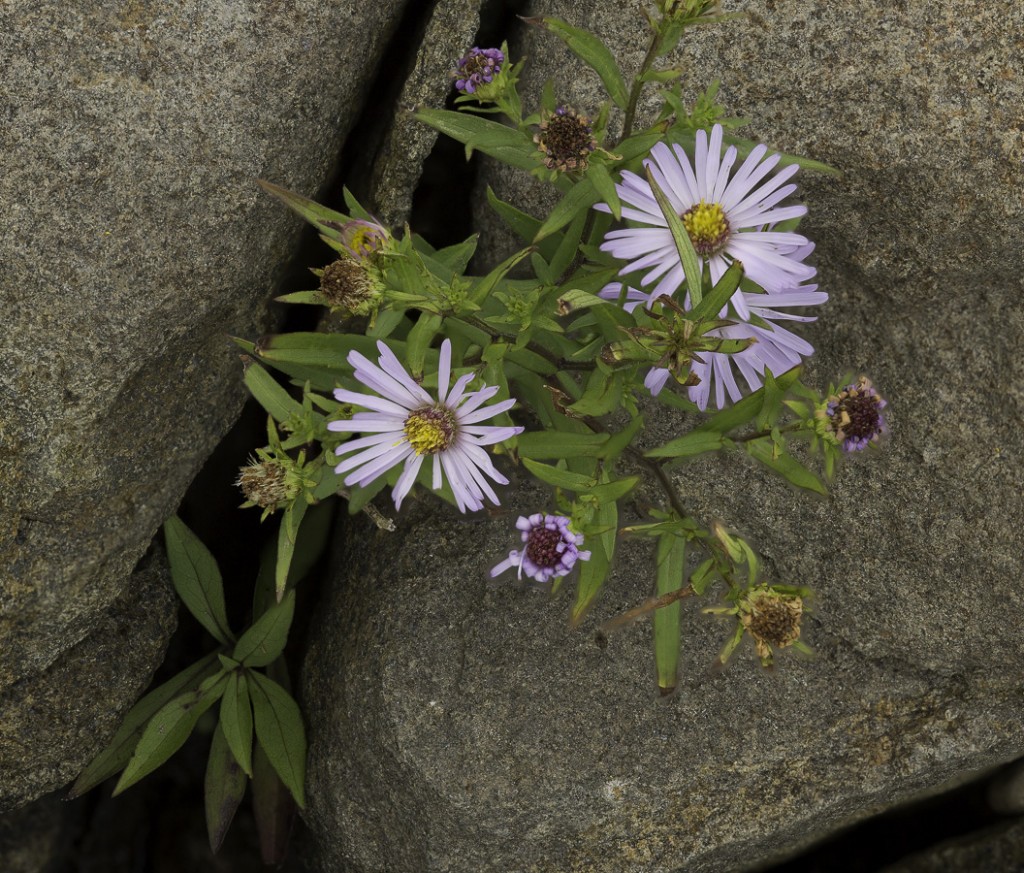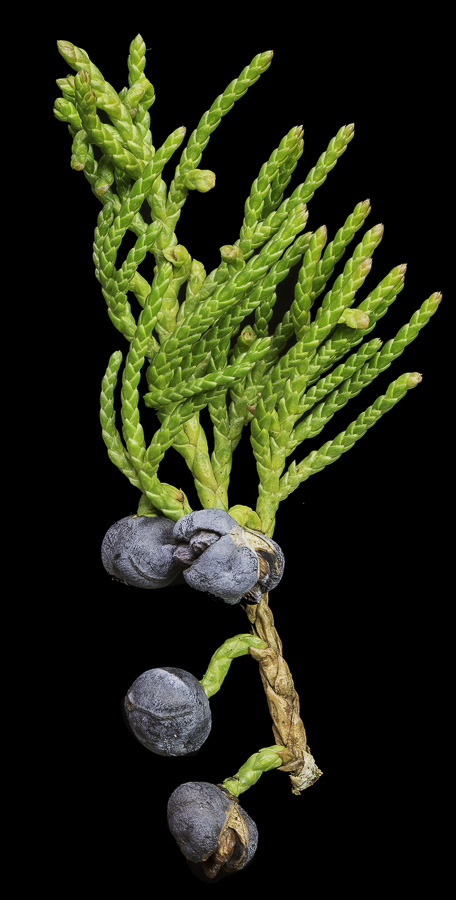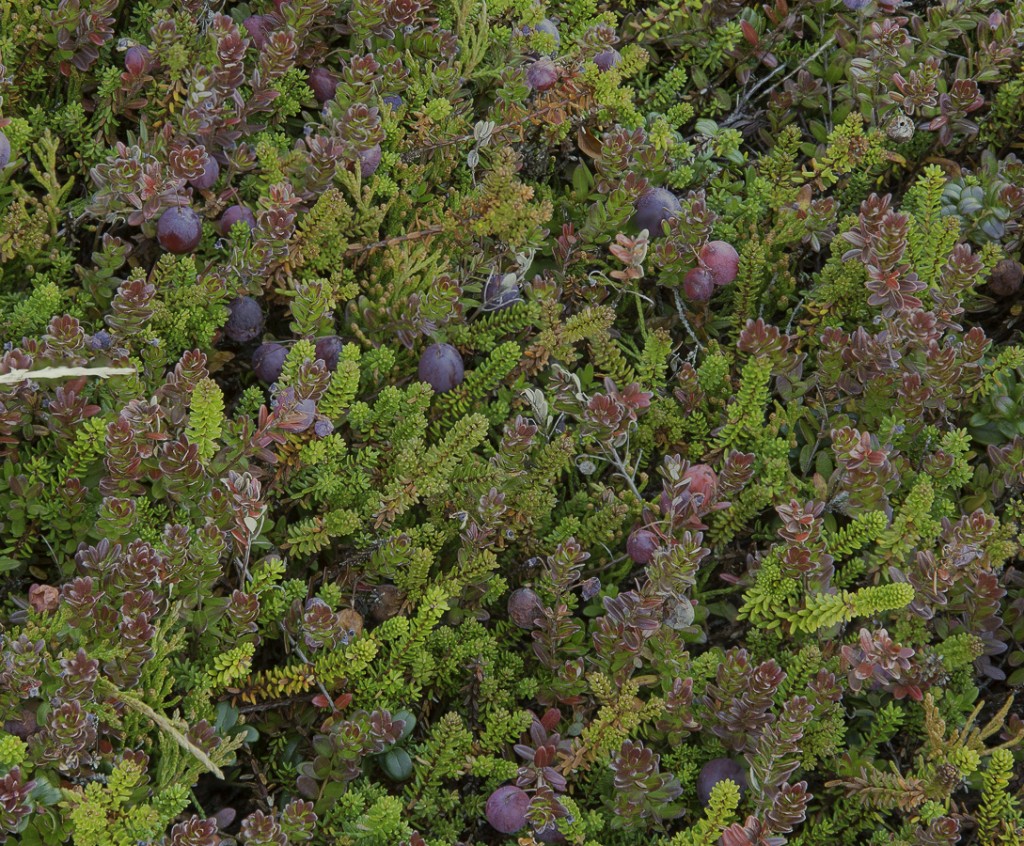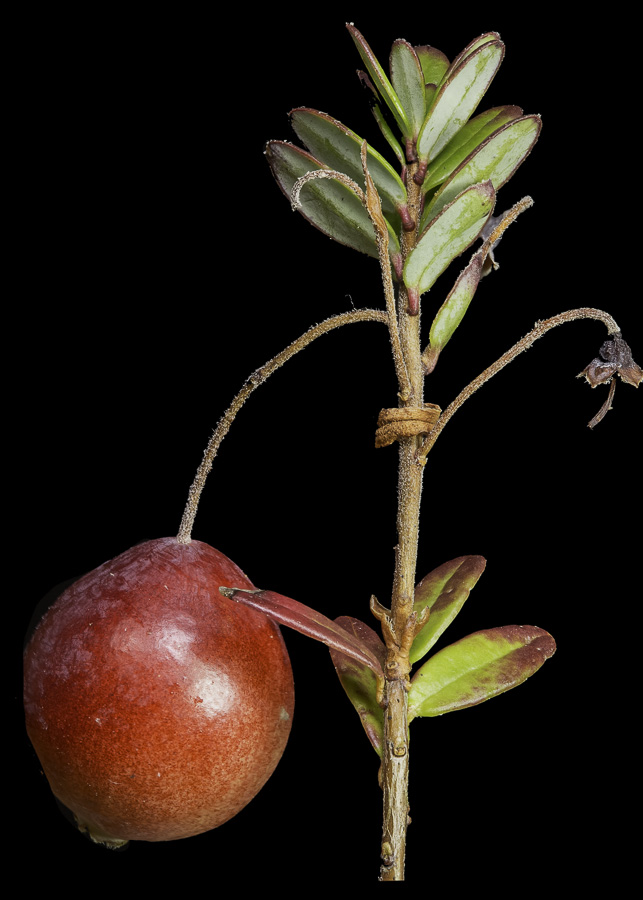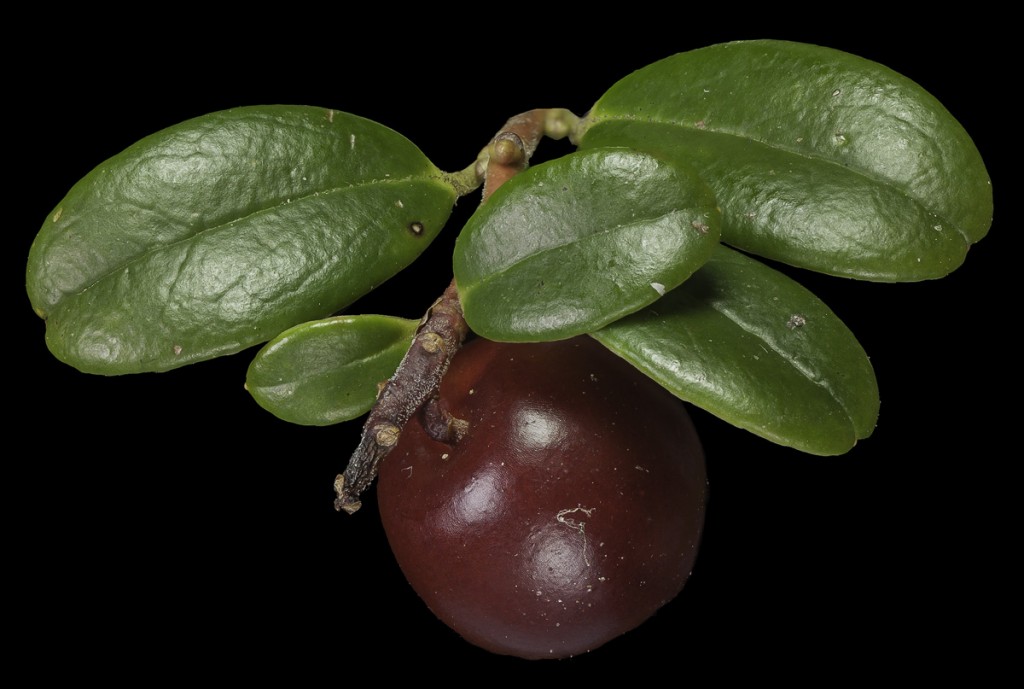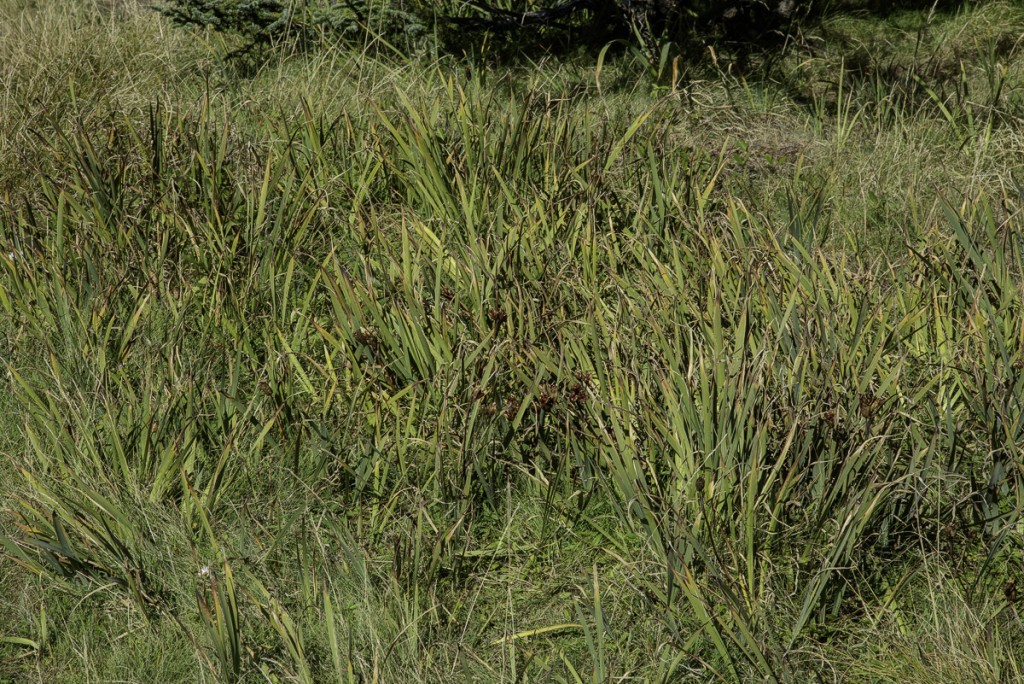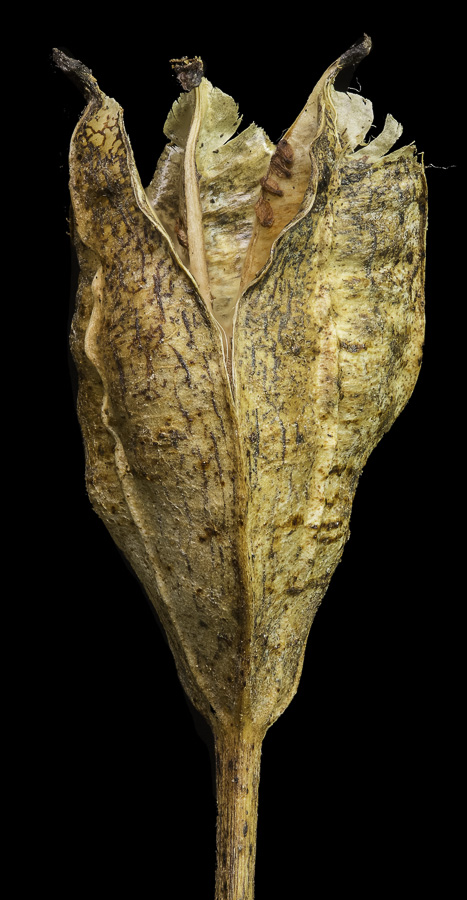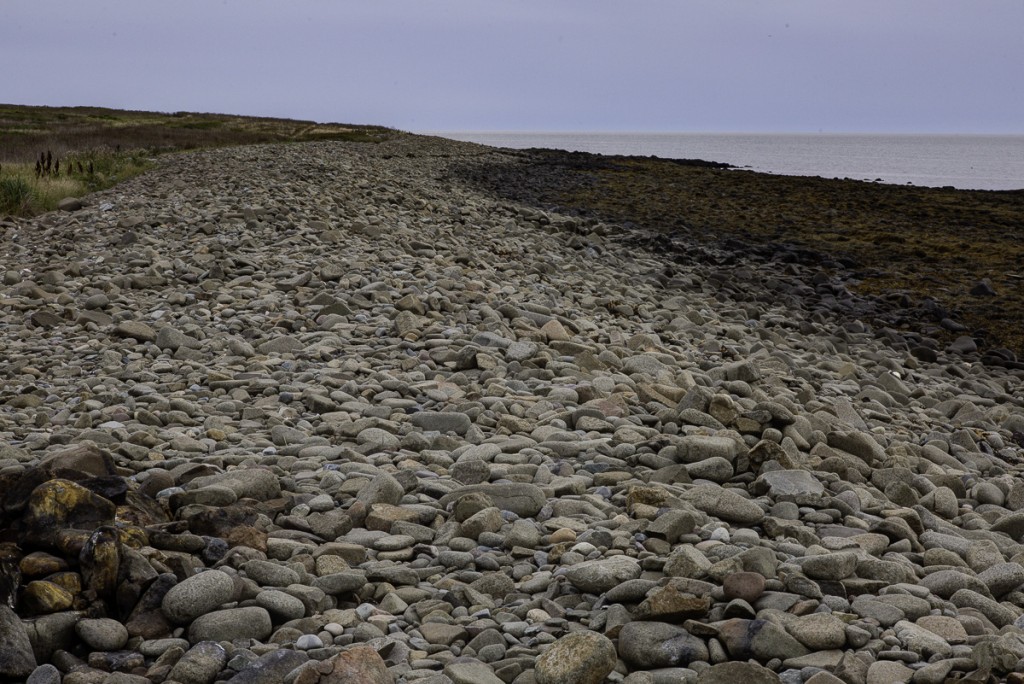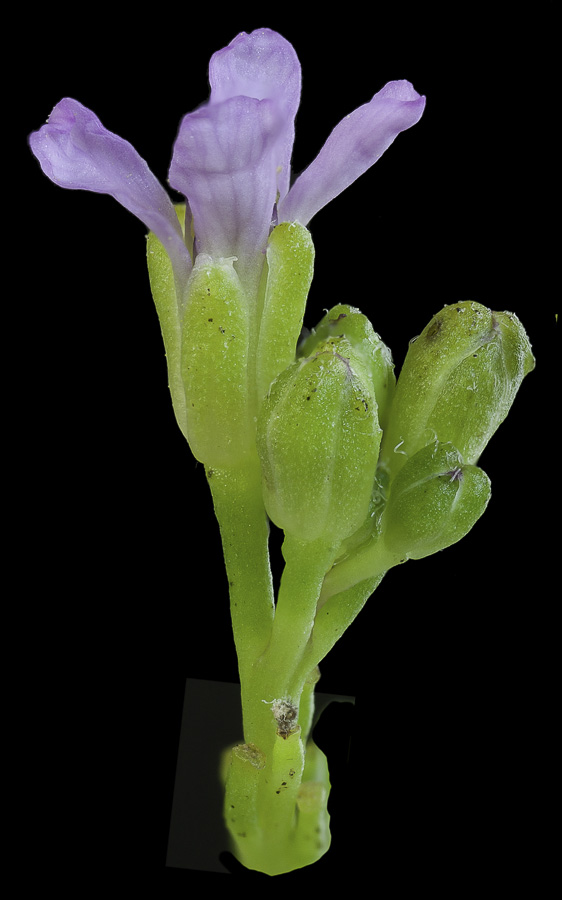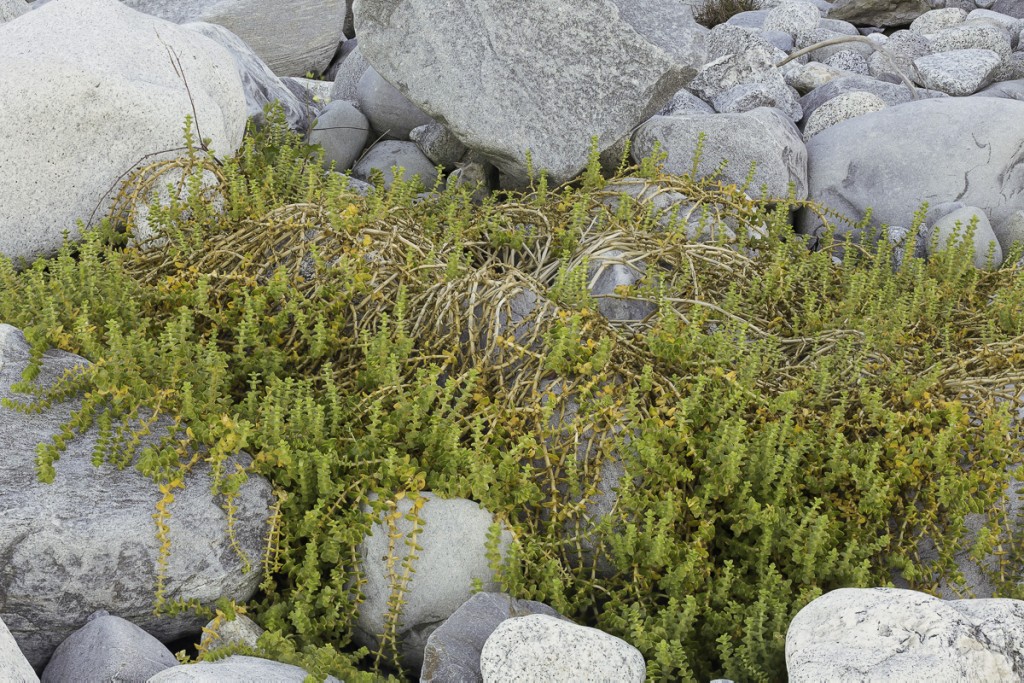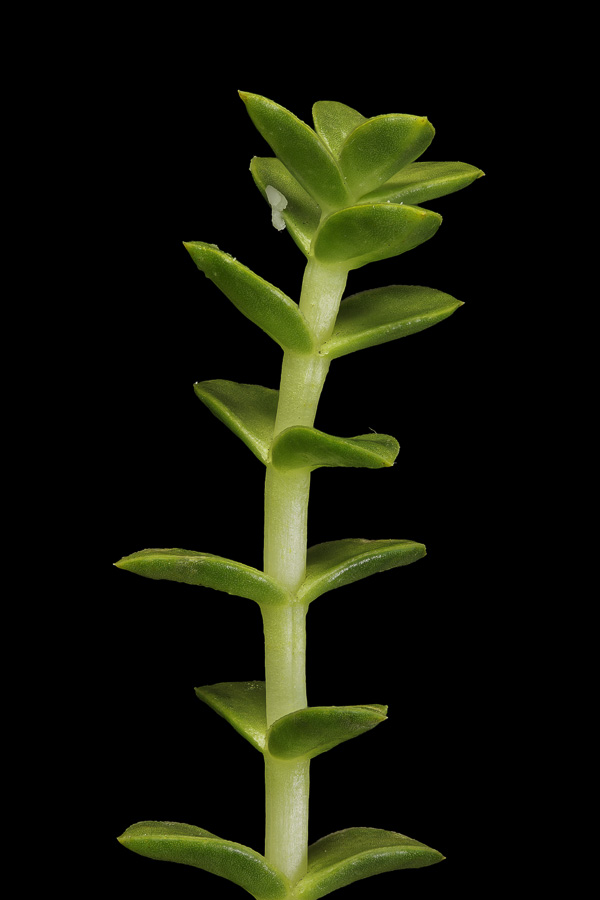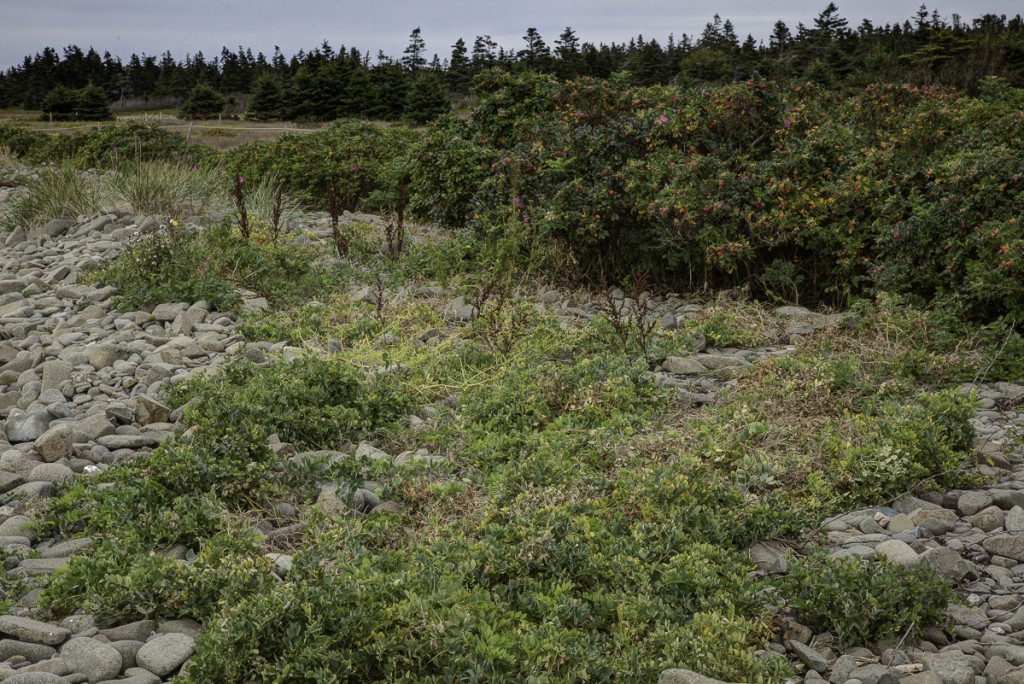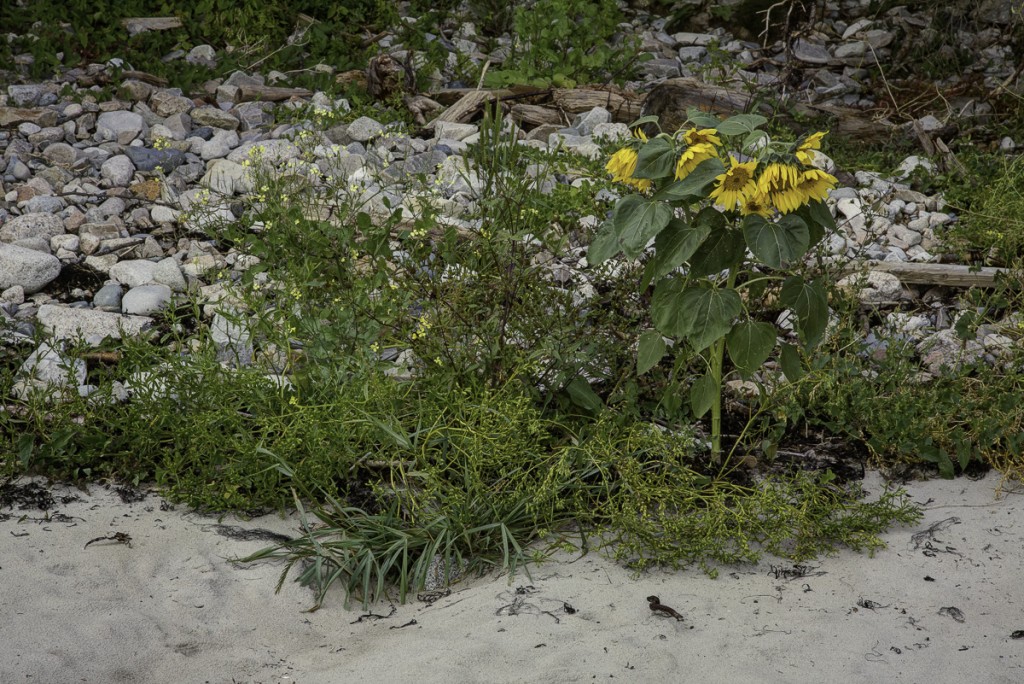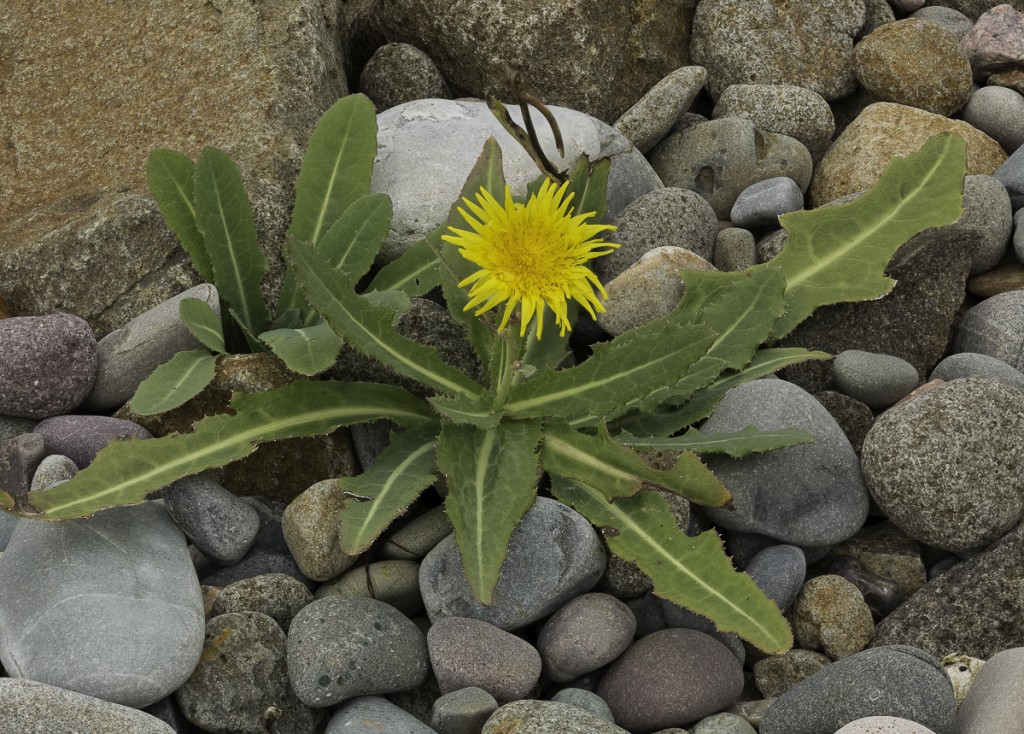In September and October, 2016, I visited eastern Maine and Nova Scotia, photographing the coast and studying vegetation. The coasts themselves are described here. This article is about the plants and where they are found. Additional pictures of sedges and woody plants are in our image library, and in this chart. Additional pictures of grasses, sedges, and herbs are in this one.
Broadly, there are three sorts of northern coasts. On rocky coasts like these, there are two vegetated zones. The rocky intertidal has marine algae. The cliff tops have small meadows or heaths and scattered plants in crevices. The zone in between, the cliff faces and the active cobble beaches, have almost no plants.
The muddy coast, shown here on the Minas Basin of Fundy but also found in coves and along tidal rivers, has extensive marshes. Where the tidal range is smaller, the marshes may extend all the way down to the low-tide level. Where it is large, as here, the whole bay empties,and the marsh are only near the high-tide level.
The stony coast, where a low shore is protected by a berm or seawall of stones, has the most vegetation and the largest number of species. Typically there are algae in the intertidal, herbs, grasses and shrubs on the berm, and thickets, meadows, marshes or bogs behind it.
The northern coastal flora is small. There are under a hundred vascular species in open coastal habitats in the spray zone, and probably another hundred in bogs, heaths, and forests slightly higher up. Some of these are habitat specialists. Mertensia maritima, sea-bluebells, only grows at the high end of gravel beaches.
The leaves are fleshy and whitened, and the flowers small and either blue or white. It is a borage, an uncommon family in our flora. In fact it one of the most northern borages, circumboreal on the arctic coasts of North America and Europe, and reaching nearly 80 degrees north in Greenland.
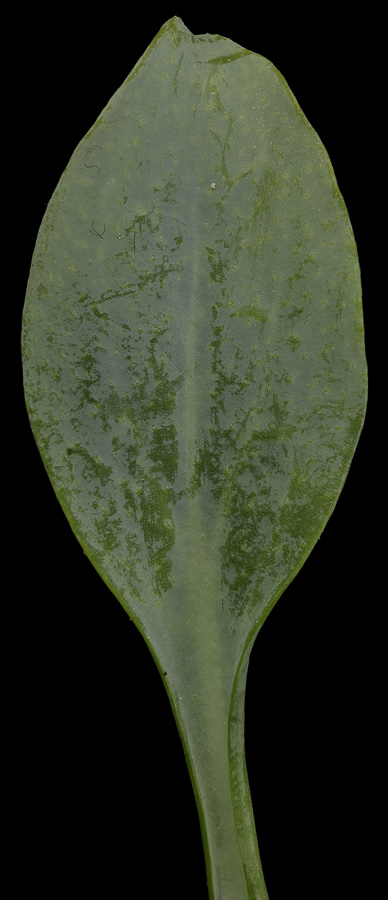

Others are generalists. Plantago maritima, seaside plantain, likes peat and tolerates submersion. It is most typical of salt marshes and rocks in the spray zone. Here it makes the low patches of turf at the edge of a Spartina band in a cove on Great Wass Island.
It is also common in cracks in rocks in the intertidal, on sea cliffs, and even, with the help of seepage, in little patches of wet turf on the tops of sea cliffs,a hundred feet or more above the shore. The leaves are fleshy, but otherwise it is quite an ordinary plantain. Here are some flowers and the inner part of the leaf base. Both are diagnostic.
The rest of this article is a photo-guide to some of the common coastal plants I photographed on my last trip, emphasizing the ones that are conspicuous landscape elements. Ecological maps and a complete photo guide will be in the pipeline, a year or so away.
Start with the soft coast. The intertidal marshes are dominated by two grasses, Spartina patens, and alterniflora. Alterniflora, in the background here, is coarser, taller, and usually lower in the tidal range. Patens, in the foreground here, is finer, often higher in the marshes, and often lies flat in late season.
Here are their flowers, patens first and then alterniflora. The tight spikes are characteristic.
Other grasses occur. The bulk of this marsh is Spartina alterniflora, but the blue-green bands are a quack grass, likely native, in the Elymus repens complex. The differences between the native and introduced forms are small, and I don’t know them well enough to say which one.
A much easier Elymus is Elymus mollis, the northern beach grass. It is a big, blue, clump-former that grows at the high-tide line on sandy beach, especially in protected coves. Here it is on Dyer Point, ME.
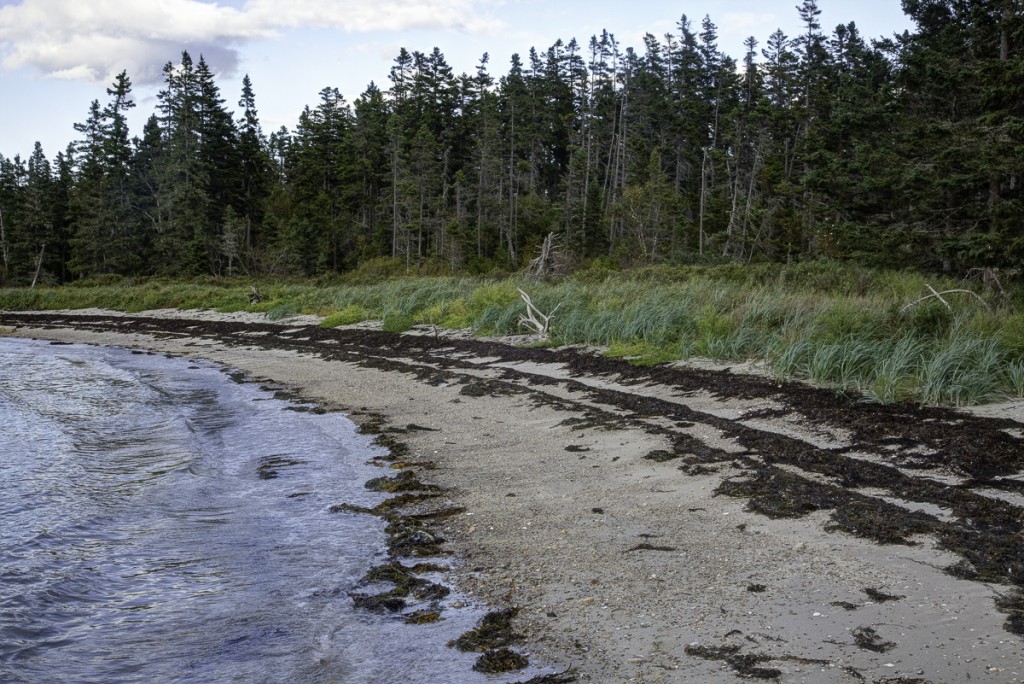
Seen closer, the flowering spikes resemble those of southern beach grass, Ammophila breviligulata, but are less dense and have the spikelets attached in two rows.
The most conspicuous sedge of the soft coast is the bulrush Bolboschoenus maritimus. It is characteristic of protected marshes and shores, especially where there is freshwater seepage. It is the coarse plant in the foreground of this marsh at Wedgeport, N.S., but doesn’t stand out well.
A little higher in the marsh, it is more conspicuous: tall, broad-leaved, turning dark in fall.
Close up, it has nice details. Here are the spikelets, with awned scales,
and the distinctive flaring nerves at the summit of the leaf sheath.
Next, the rocky coast. The intertidal is dominated by two more more species of rockweed, with smaller amounts of other seaweeds. The commonest three are shown here: Ulva lactuca, sea lettuce, in the pool in the foreground; Ascophyllum nodosum, yellow wrack, the stringy yelow plants on the rocks; and Fucus vesiculosus, bladder wrack, dark and clumped with yellow bladders.
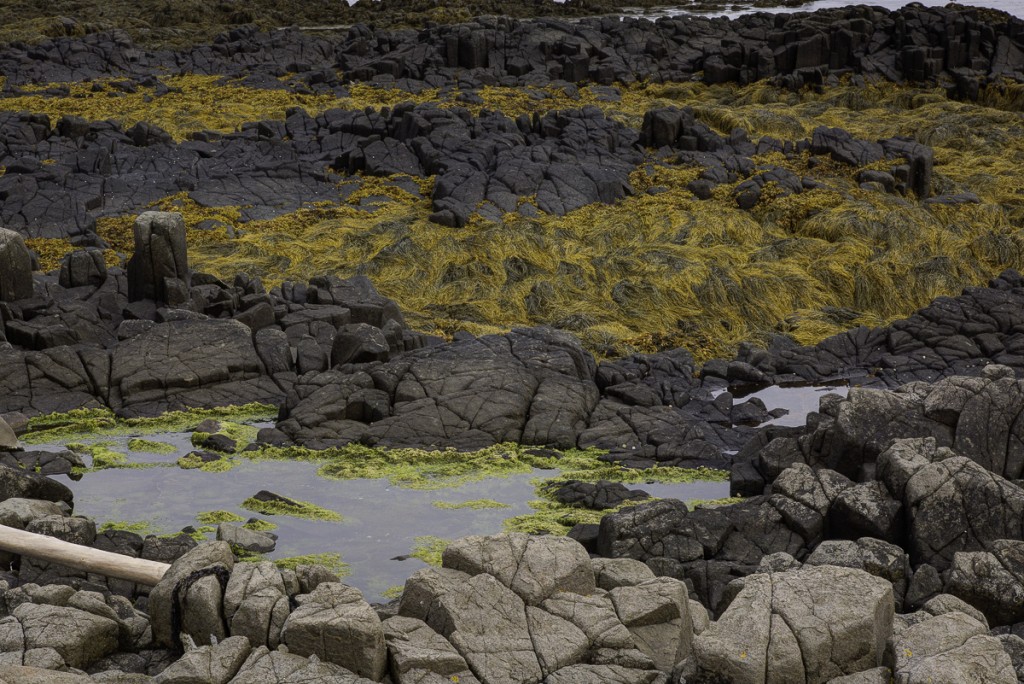
The cliff faces above the tide line, like these at Anthony Provincial park, N.S.,
or these on Quoddy Head, ME,
are often dry and barren, with only small amounts of vegetation. The most distinctive communities are on the cliff-tops. At Anthony, for example, there were interesting hanging meadows, with bayberry and white spruce spruce. The grass is mostly red fescue, and the flower is Aster novi-beligii, New York aster.
Here is novi-belgii up close, in a crack in basalt just above the high-tide line.
Some of the cliff-top meadows at Anthony Park were quite wet. This one, shot with a telephoto, had Juncus balticus, a rush that is characteristically found around fresh-water seeps on shores and in salt marshes.
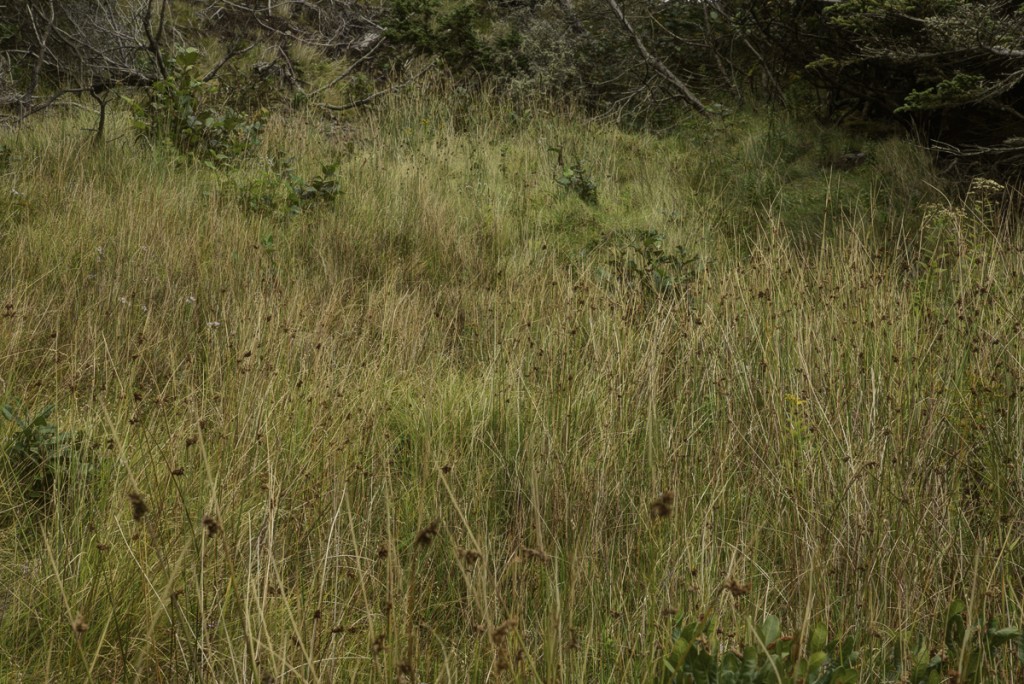
Here it is flowering, in June.
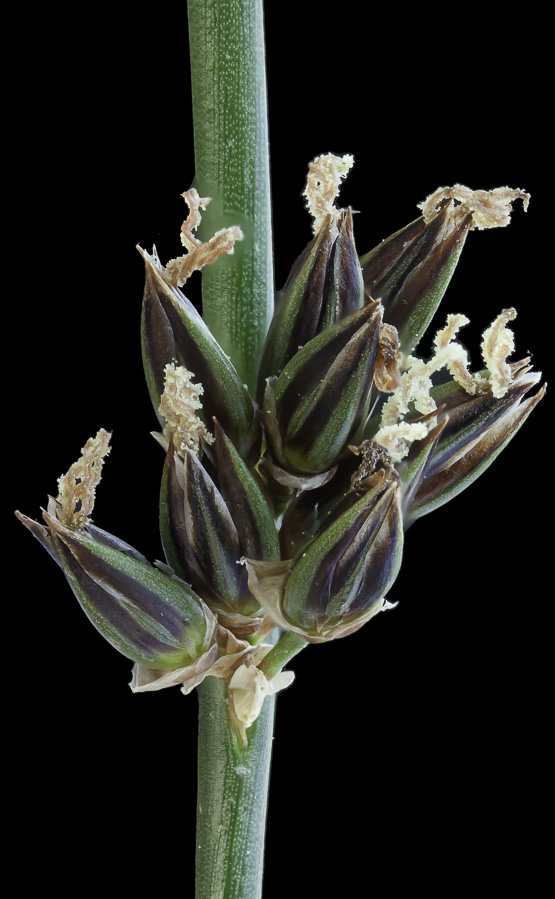
The tops of the cliffs at Quoddy Head were dryer and barer. They typically had low, matted, woody species—juniper, crowberry, other heaths. Here is Juniperus horizontalis, creeping juniper, with crowberry and stunted white spruce.
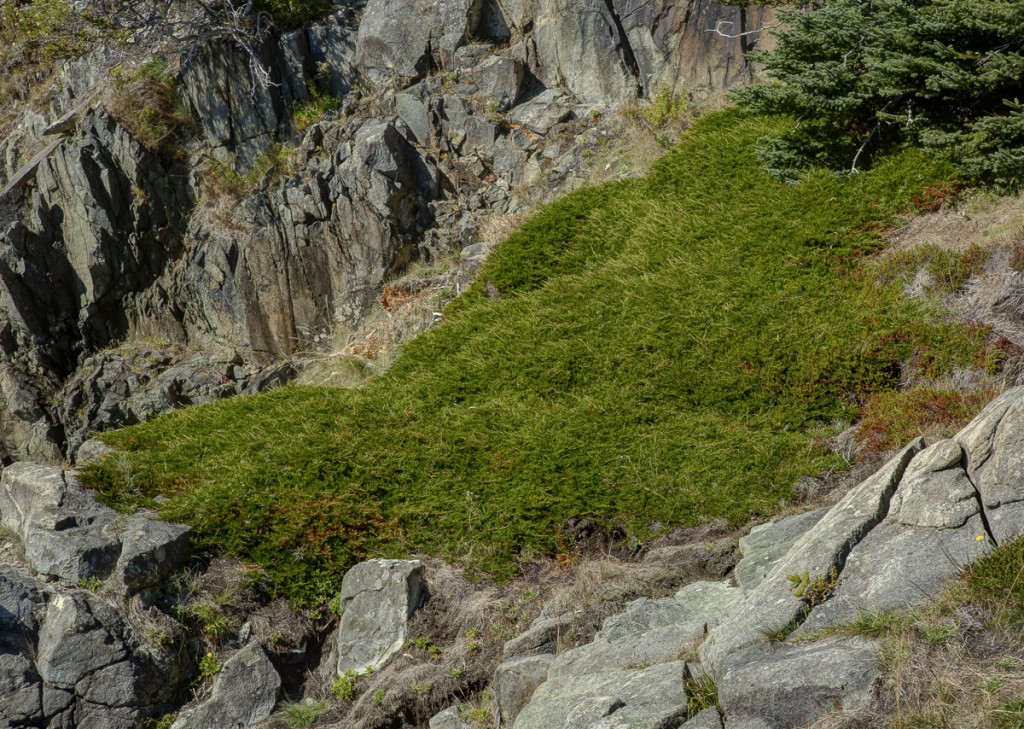
Creeping juniper is a transcontinental, subarctic species. It is a calciphile in many places. The creeping habit and the hooked stalks of the fruit are its best characters.
Crowberry, Empetrum nigrum, is very common on these clifftops and can form extensive mats. It has narrow leaves and looks a bit like a spruce twig. Here it is mixed with the large cranberry (Vaccinium macrocarpon) and a few plants of mountain cranberry (Vaccinium vitis-idea).
The large cranberry has narrow-oval leaves which are whitened below and large fruit.
The mountain cranberry has broader, strongly grooved leaves with notched tips.
A few of the cliff-tops at Quoddy have wet meadows. This one had a large patch of an iris with small pods. My guess, and I would be pleased to hear from someone who knows, is that this is the beachhead iris, Iris hookeri, a characteristic species of the North Atlantic coast.
The last shore type, the stony shores, typically have a flat tidal flats which grade upward into a berm of stones. The berm is often higher that the land behind it. Where stones are mobile, as here on Brier Island, N.S., it may have no plants at all.
Where the stones are more stable and soil can accumulate, the berm may be continuously vegetated. Here, in a more protected site on Brier Island, it has beachgrass and shrubs.
The black bands of seaweed on the face of the berm are drift lines. They hold moisture and are rich in nutrients.
Several of the berm species, especially the annuals, use the drift lines as seed beds. Here is Cakile edentula, sea rocket, perhaps the commonest native species on active cobble shores.
Like many of our beach plants, Cakile is northern, wide-ranging, and has close relatives in Europe. Here are its flowers and fruits.
Honckenya peploides, sea-beach sandwort, is a perennial that grows both in sand and on rocks. Like the sea rocket it is fleshy, sprawling, and widely distributed on northern coasts.
Close up, it is distinctive: fat stems, stiff fleshy leaves.
The top of the berm is the place where rocks come to rest and hence more stabile than the front slope. It is typically fertile and continuously vegetated. The flora is typically a mixture of grasses, herbs, and low shrubs. Usually there are both American and European species.
Here, for example is the native Lathyrus japonicus, beach pea, and Elymus mollis, beach grass, with sow thistle, bindweed, and rugosa rose, all aliens, on a stabilized berm.
The beach-pea flower, a typical bean.
Here, from Dyer Point, another native-alien mixture on a berm top: Raphanus raphanistrum, wild radish, a garden sunflower, beach grass, and sea rocket.
Altogether, over a dozen alien herbs and grasses occur on the berms or in the meadows behind them. This contrasts with the salt marshes, bogs, heaths, and cliff shores which have almost no aliens at all.
The are probably two explanations for this. First, because the berms are fertile and regularly disturbed, they are perfect places for weedy species. Second, and more interesting to me, stony beaches are the ancestral home of many of our common European weeds. The wild radish is native on rocky shores in Britain and Europe. Likewise the sow thistle, Sonchus arvensis, common on the berms and in coastal meadows, is alien here but native on European coasts.
From this perspective, the aliens and natives are not that different. All are northern coastal plants that have shifted their distributions many times as the glaciers came and went. Some are currently circumboreal. Others are limited to one continent but with close relatives in others. Some are dispersed by wind, some by birds, some by humans. And all, biogeographically, are citizens of the whole interconnected north.
Another common group of berm plants, also annuals and also weedy, is the chenopods. The commonest genera are Atriplex, orach, and Chenopodium, goosefoot. Two other genera, Suaeda, sea blite, and Salicornia, salt-wort, are mostly on the soft shores but can occur between rocks as well. Here is a thicket of Chenopodium and Atriplex on the front face and crest of a berm.
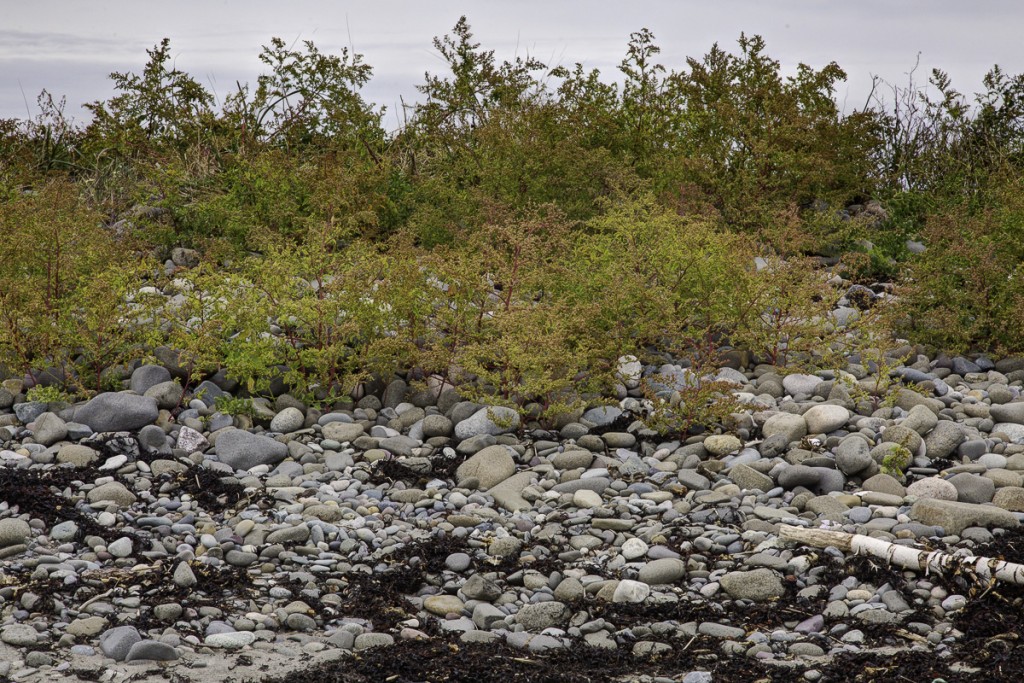
And here and even bigger chenopod tangle between a berm and a saltmarsh.
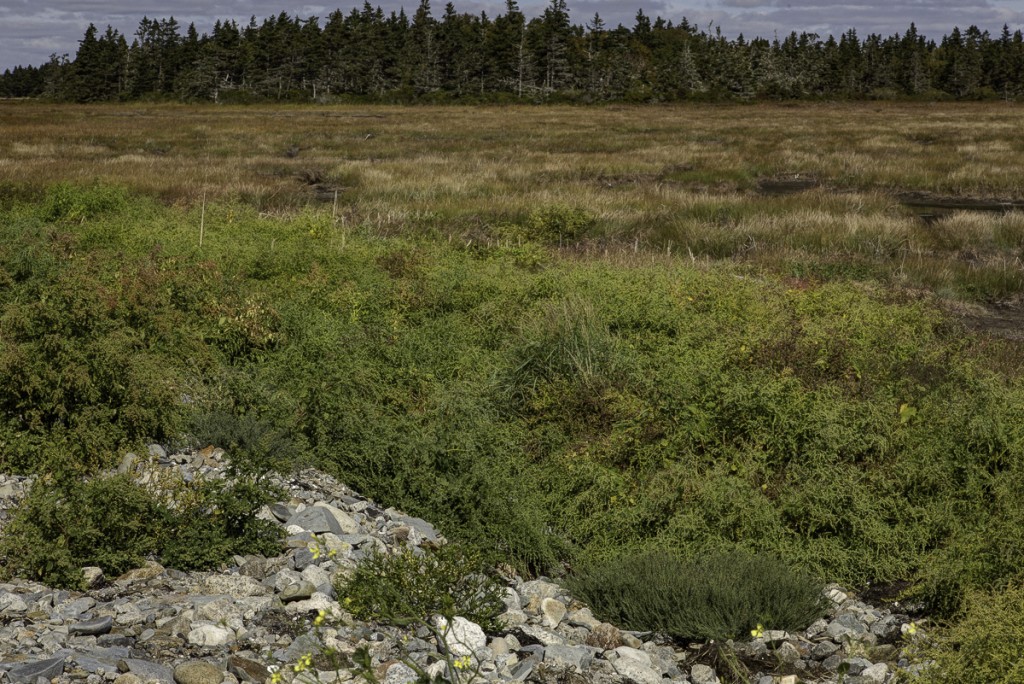
I have, and in fact always have had, trouble naming them. Frankly, almost everyone I know does too. The problem is not the number of species—currently most authors currently recognize about four northern species of Atriplex and three of Chenopodium—but the great variability and consequent uncertainty about what characters to use to separate them.
Each time I go north, I think “This year I’ll figure them out,” but so far it hasn’t happened. Until I go and have another look, I think this one from the stony berm face, with horizontal seeds with a minutely bumpy surface is Chenopodium berlandieri.
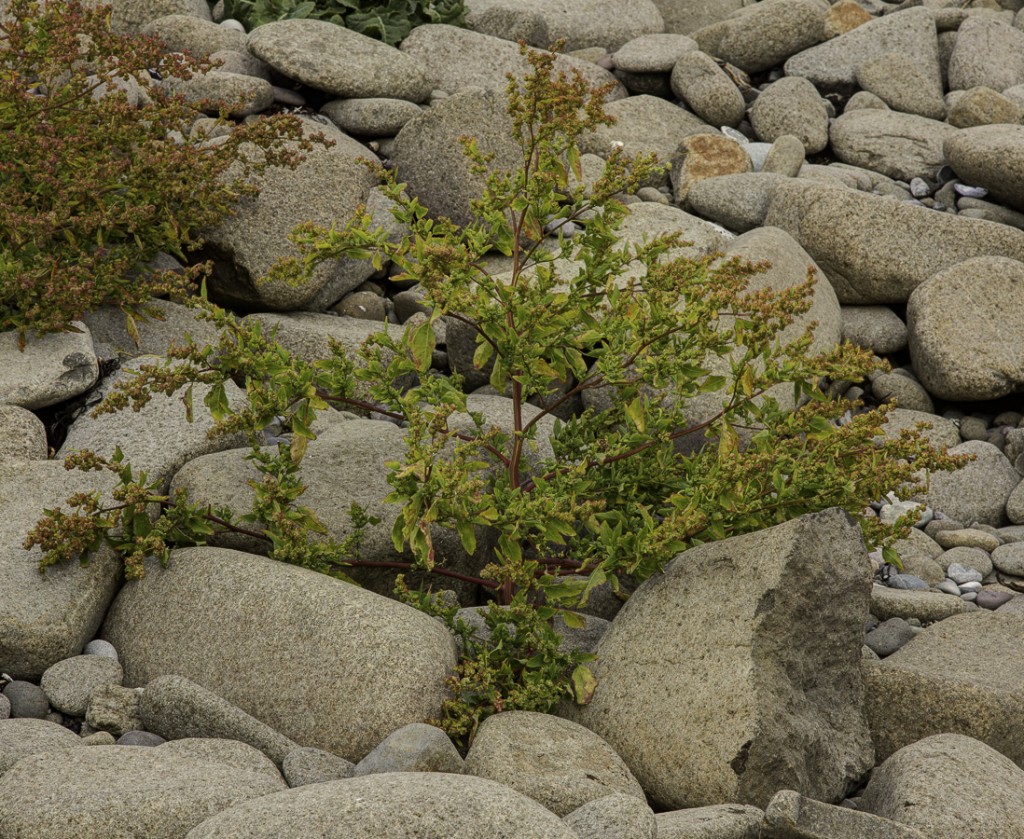
This one, the most common of all, with triangular leaves and fleshy bracts covering the seeds, is Atriplex prostrata.
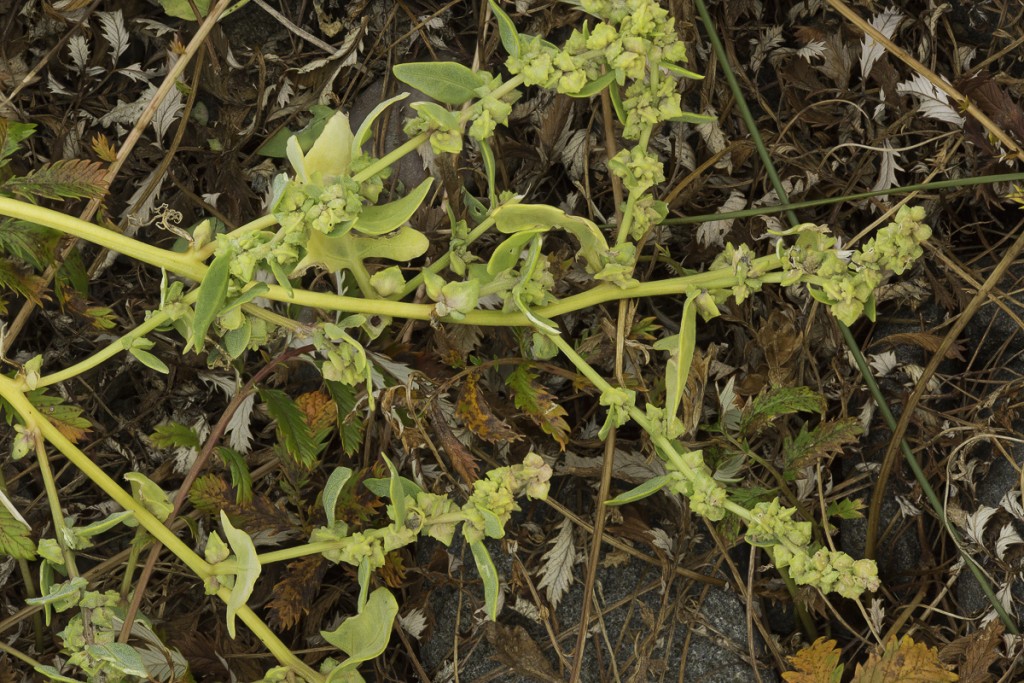
This one, with consistently narrow leaves, is Atriplex littoralis.
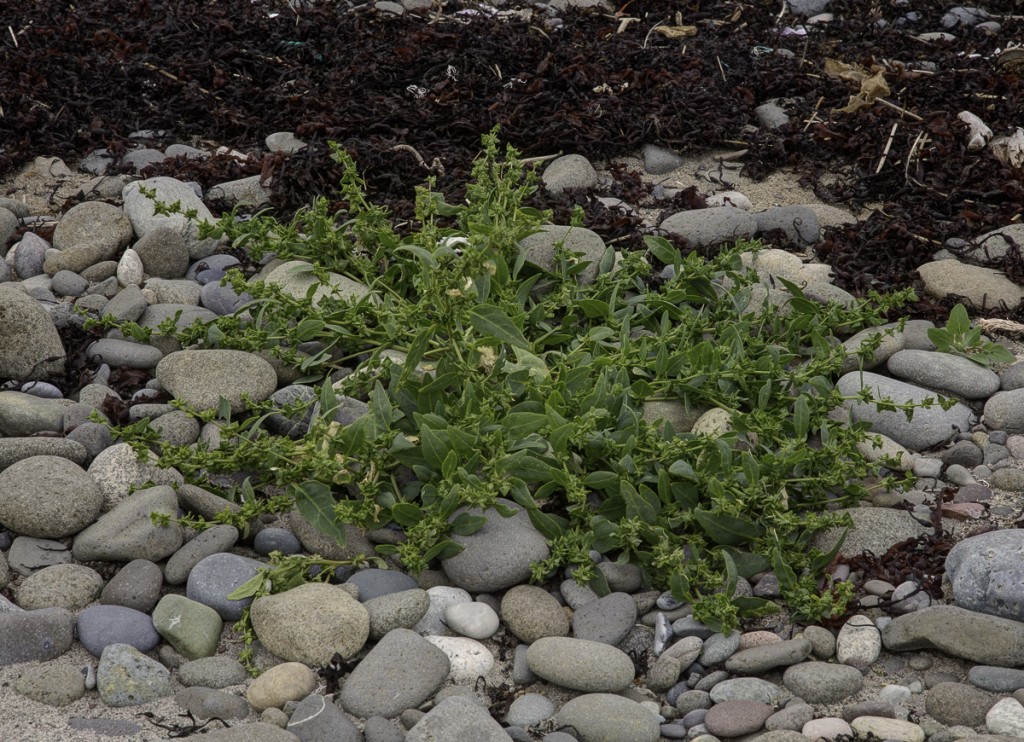
And this one, with triangular leaves and leafy bracts in the flower clusters might be Atriplex glabriuscula or a form of prostrata. Or, it might be, as was long believed that glabriuscula is, just a form of prostrata hastata.
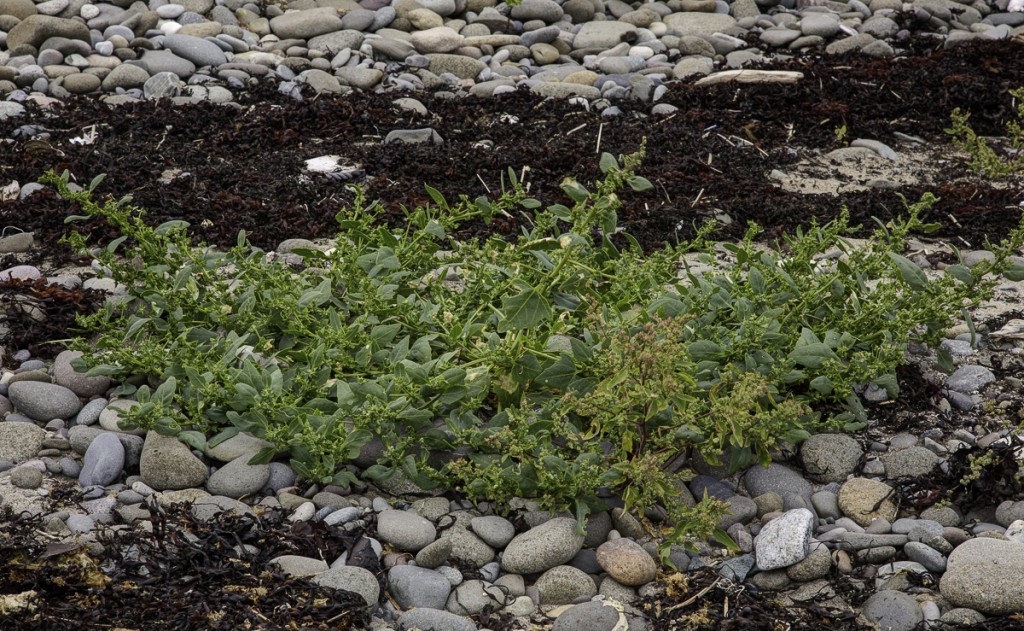
Confusing of course, but exuberant. And a problem for another year and perhaps another botanist.
Every good wish as the oak leaves fall,
Jerry J., 26 October, 016.
